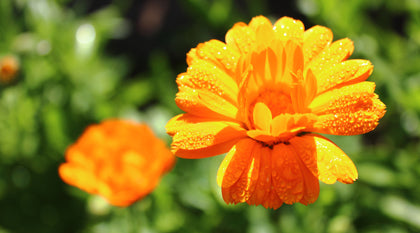Nicknamed the “sunshine flower”, calendula fills up gardens with bright yellow and orange blossoms. With a strong connection to the sun’s movement across the sky, calendula opens its colorful petals when the sun shines, and retreats as the sun fades. Derived from the Latin term calendae, meaning “little calendar”, this flower serves as Mother Nature’s clock, often blooming on the first of the month.
IDENTIFICATION
Calendula flowers resemble a sunburst and plants thrive on minimal care, often reaching up to two feet in height upon harvest. While native to the Mediterranean region, calendula is a sturdy plant and can be grown in a variety of climates worldwide. The plant’s ability to easily reseed itself has allowed for it to be a low-maintenance flower in home gardens, attracting bees for pollination.
HISTORICAL USE
Calendula has been grown and utilized for medicinal and ritual purposes in many cultures dating back to the 12th century. Calendula’s sunny blooms brightened up the gardens of ancient Romans who used the flowers to garnish dishes and create crowns or garlands as cheerful additions to ceremonies. The Romans also quickly learned that the power of this plant surpassed its aesthetic beauty, using the flower to heal scorpion bites and relieve stings.
Early Christians referred to the flower as “Mary’s Gold”, a name still commonly known as “marigold”, symbolizing the Mother Mary at holy events. Aztecs used the herb in rituals, often wearing the flowers on ceremonious attire. They too discovered its medicinal uses, using the flower to heal cuts and illnesses while also incorporating it into culinary dishes. Calendula flowers are considered sacred in India and have been used to decorate the statues of Hindu deities and to give vibrancy to cosmetics and dyes. The use of the flower remains popular in Central America today. It is used in Day of the Dead celebrations, decorating altars and adorning cultural celebrations.
As settlers came to America, colonists depended on the flower’s sunny nature and its medicinal properties for protection against the harsh seasons. They relied on the flowers’ blossoming as reassurance that sunny days were ahead. During times of war, soldiers would use calendula to treat open wounds, which stopped bleeding and accelerated the healing process. This practice was relied on heavily by doctors and nurses since it proved time and time again to successfully heal wounds and reduce the risk of infection on the battlefront.
MEDICINAL USE
Often, calendula is attributed to good health and positive outcomes. It has been said that smelling the flowers prior to bed, or sleeping with them under your pillow, welcomes psychic or prophetic dreams. Like the sun it represents so well, soaking in an herbal bath of calendula flowers is thought to give one a healthy glow. Other practices include carrying the flowers in your pocket to bring positivity and inhaling the floral scent for good health, specifically to improve eyesight.
As one of the best multi-purpose flowers, calendula is still commonly used on rashes and wounds, to soften skin, and ease swelling. The herb’s ability to help mend wounds has been attributed to it causing an increase in blood flow and oxygen to the exposed area, aiding in tissue growth. With a nourishing effect, calendula can be used in balms, oils, or salves to heal dry skin, leaving the body feeling renewed, and skin softened. Calendula has been recognized for centuries for its multipurpose uses and for its sunshine-like beauty. Its ability to aid and support the healing process of cuts and chapped skin has been one of the fundamental reasons calendula remains present in a multitude of herbal healthcare products.
Grown on our very own organic farm, and with so many beneficial uses, it’s no surprise you’ll find calendula in a variety of Motherlove products, including our Pregnant Belly Oil, Pregnant Belly Salve, Nipple Cream, Diaper Balm, Rhoid Balm, and Green Salve!




